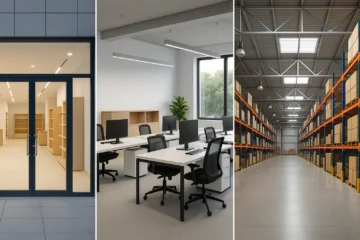Introduction
The commercial real estate landscape in the United Kingdom is rich with diverse leasing options, tailored to meet the evolving needs of businesses. Whether you’re a startup seeking a budget-friendly workspace, a multinational company looking to establish a flagship office, or a freelancer in need of a professional business address, understanding the nuances of various lease types is essential.
This article provides an in-depth exploration of four key commercial leasing options: business centers, traditional offices, coworking spaces, and virtual offices. By examining their unique features, benefits, and drawbacks, we aim to help you make an informed decision that aligns with your business goals.
Business Centers
Definition and Features
Business centers are fully serviced office spaces that cater to the needs of businesses seeking convenience and efficiency. They often come equipped with shared amenities such as reception services, IT support, conference rooms, and utilities. Business centers are typically located in prime urban areas, offering businesses a professional setting without the high cost of a traditional office lease.
Target Audience
- Small to medium-sized enterprises (SMEs)
- Startups looking for scalable solutions
- Expanding businesses testing new markets
Lease Flexibility
Business centers are known for their flexible leasing terms, ranging from a few months to a couple of years. This flexibility allows businesses to adjust their space needs as they grow.
Advantages
- Cost-effective: Shared amenities reduce overhead expenses.
- Prestigious locations: Often situated in business districts.
- Turnkey solutions: Minimal setup time required.
Disadvantages
- Limited customization: Tenants have little control over design and layout.
- Shared facilities: Reduced privacy for certain operations.
Traditional Offices
Definition and Features
Traditional offices are standalone spaces leased for exclusive use. They provide tenants with complete control over the layout, branding, and operations of the space. These offices are often leased on a long-term basis, requiring a significant commitment from the tenant.
Target Audience
- Established businesses with stable operations
- Companies requiring a large amount of private space
Lease Structure
Leases for traditional offices typically span 5-10 years, with tenants bearing the responsibility for maintenance, utilities, and often renovations.
Advantages
- Full control: Customize the space to reflect your brand.
- Enhanced privacy: Ideal for sensitive business operations.
- Professional image: Traditional offices often convey stability and prestige.
Disadvantages
- High costs: Initial setup and ongoing expenses can be substantial.
- Limited flexibility: Long-term leases may not suit rapidly changing business needs.
Coworking Spaces
Definition and Features
Coworking spaces are shared work environments designed to foster collaboration and innovation. These spaces provide access to desks, meeting rooms, and communal areas on a membership basis. They often host networking events, making them hubs for creativity and connection.
Target Audience
- Freelancers and remote workers
- Startups seeking affordable workspace
- SMEs looking for networking opportunities
Lease Flexibility
Coworking spaces offer unparalleled flexibility, with options for daily, weekly, or monthly memberships.
Advantages
- Affordable: Pay only for the space you use.
- Networking: Connect with like-minded professionals.
- Fully serviced: Access to high-speed internet, printing, and other facilities.
Disadvantages
- Privacy concerns: Shared spaces may lack the confidentiality required for some businesses.
- Noise and distractions: Can affect productivity in open-plan setups.
Virtual Offices
Definition and Features
A virtual office provides businesses with a professional address and administrative support without the need for physical workspace. This model is ideal for businesses that operate remotely but require a formal presence in a specific location.
Target Audience
- Home-based businesses
- Freelancers
- International companies entering the UK market
Lease Flexibility
Virtual offices operate on a subscription basis, offering monthly or yearly plans.
Advantages
- Cost-efficient: A fraction of the cost of physical office space.
- Professional image: Prestigious addresses in central locations.
- Administrative support: Mail handling and phone answering services included.
Disadvantages
- No physical workspace: Suitable only for remote operations.
- Limited services: Depend on the provider’s offerings.
Comparative Analysis of Lease Types
| Lease Type | Flexibility | Cost | Target Audience | Advantages | Disadvantages |
| Business Centers | High | Moderate | SMEs, Startups | Cost-effective, shared amenities | Limited customization |
| Traditional Offices | Low | High | Established Businesses | Full control, brand enhancement | High initial costs, long-term |
| Coworking Spaces | Very High | Low-Moderate | Freelancers, SMEs | Networking, affordable | Privacy concerns, potential noise |
| Virtual Offices | Very High | Low | Startups, Home Businesses | Professional image, affordable | No physical workspace |
Factors to Consider When Choosing a Lease Type
- Business Size and Growth Potential: Startups may opt for flexible options like coworking spaces or business centers, while established companies might prefer traditional offices.
- Budget Constraints: Evaluate upfront costs and ongoing expenses.
- Location Preferences: Access to clients, partners, and transportation.
- Operational Needs: Privacy, collaboration, and brand image considerations.
Conclusion
Selecting the right commercial lease is a critical decision that impacts a business’s operational efficiency and financial health. Whether you need the flexibility of a coworking space or the exclusivity of a traditional office, understanding the pros and cons of each option ensures a strategic choice. Explore the diverse commercial real estate options in the UK to find the perfect fit for your business.
FAQ Section
1. What is the most flexible commercial lease option?
Coworking spaces and virtual offices offer the highest flexibility, with daily or monthly agreements that suit dynamic business needs.
2. How do I decide between a business center and a traditional office?
Consider your need for flexibility versus control. Business centers offer shared resources and short-term leases, while traditional offices provide full autonomy but require a long-term commitment.
3. Are virtual offices suitable for growing businesses?
Virtual offices work well for businesses that do not require physical space but need a professional address and administrative support.
4. Can coworking spaces accommodate large teams?
Yes, many coworking spaces offer dedicated team areas and private offices to accommodate larger groups. However, privacy may still be a concern.


